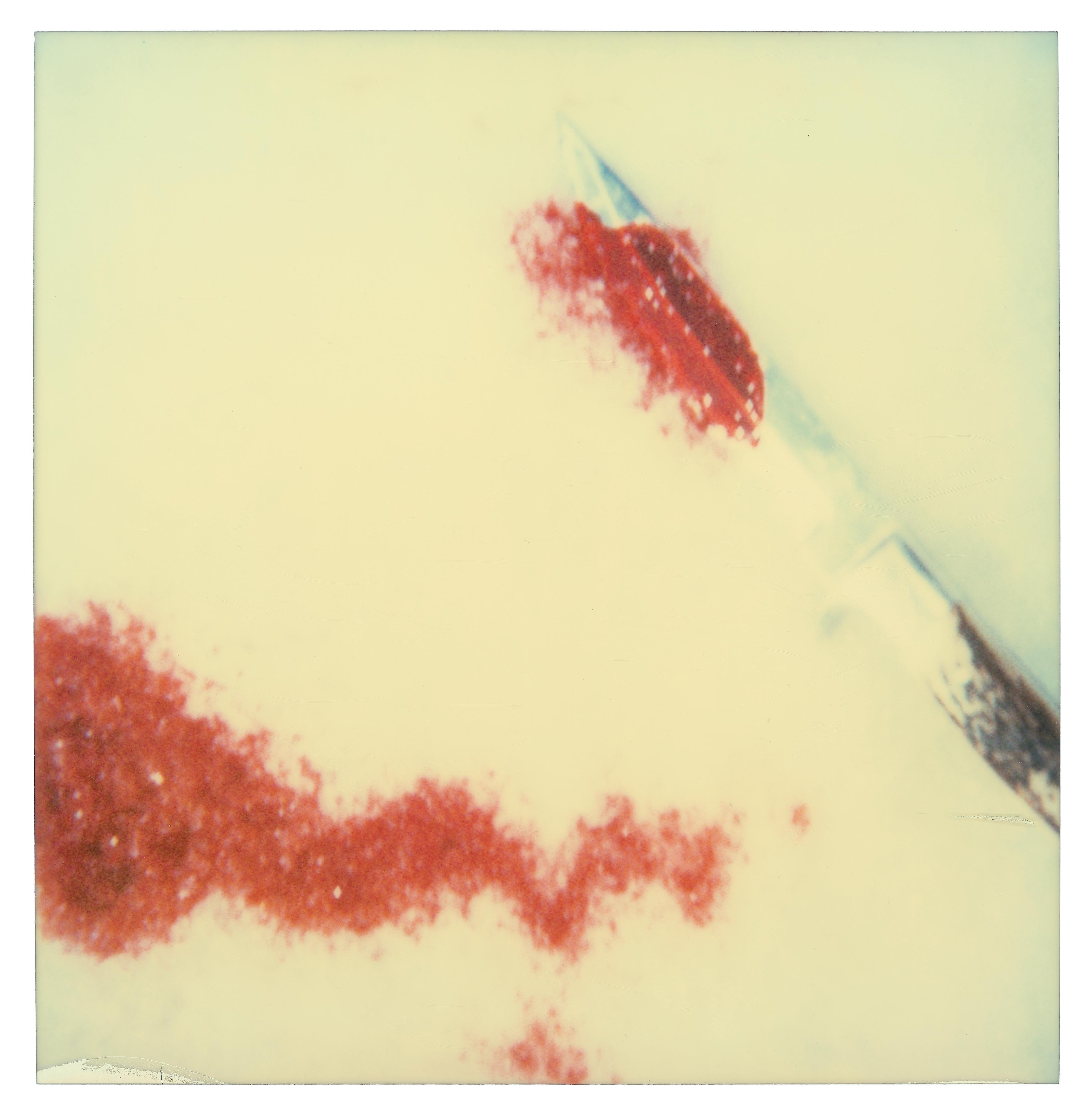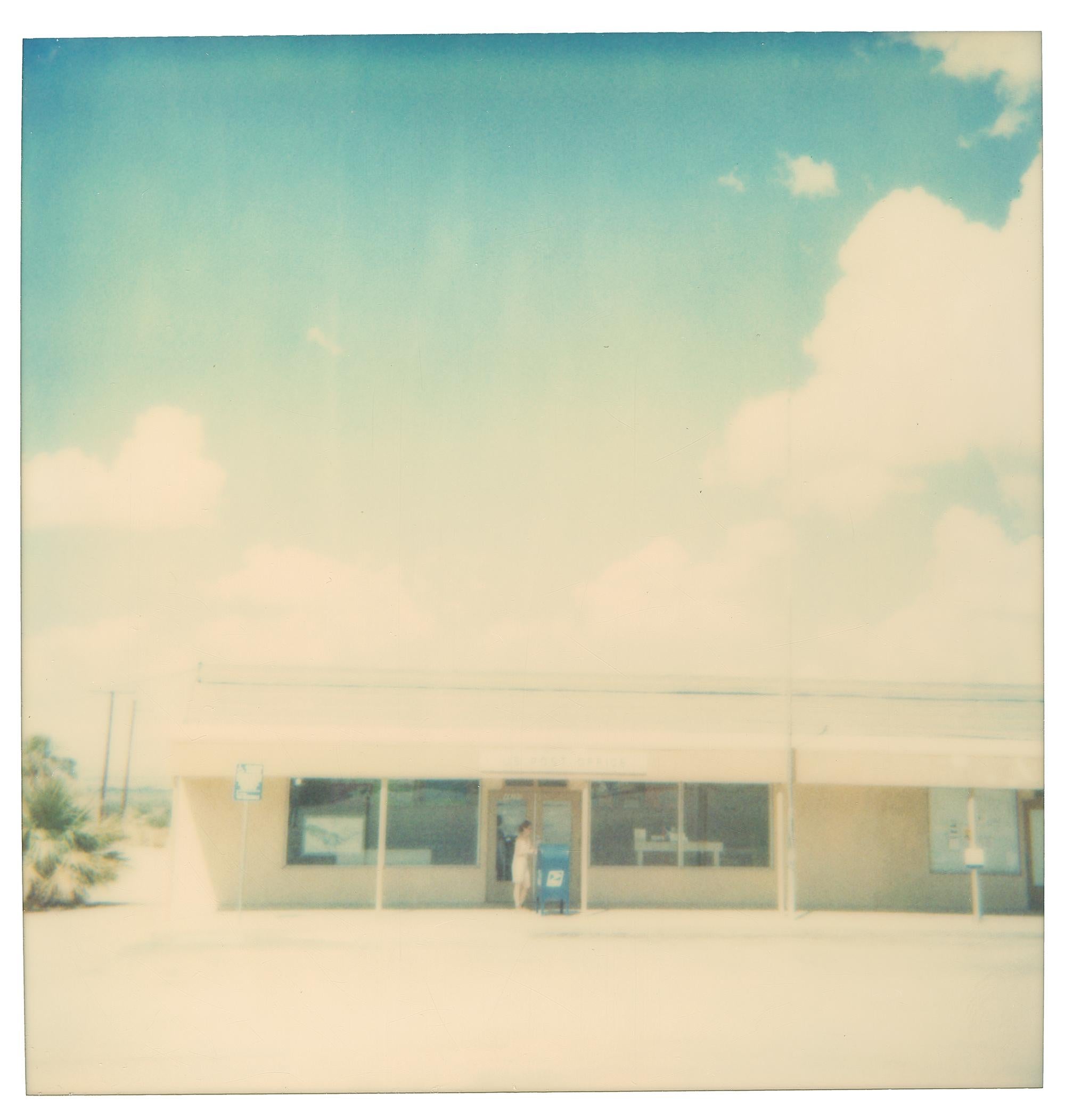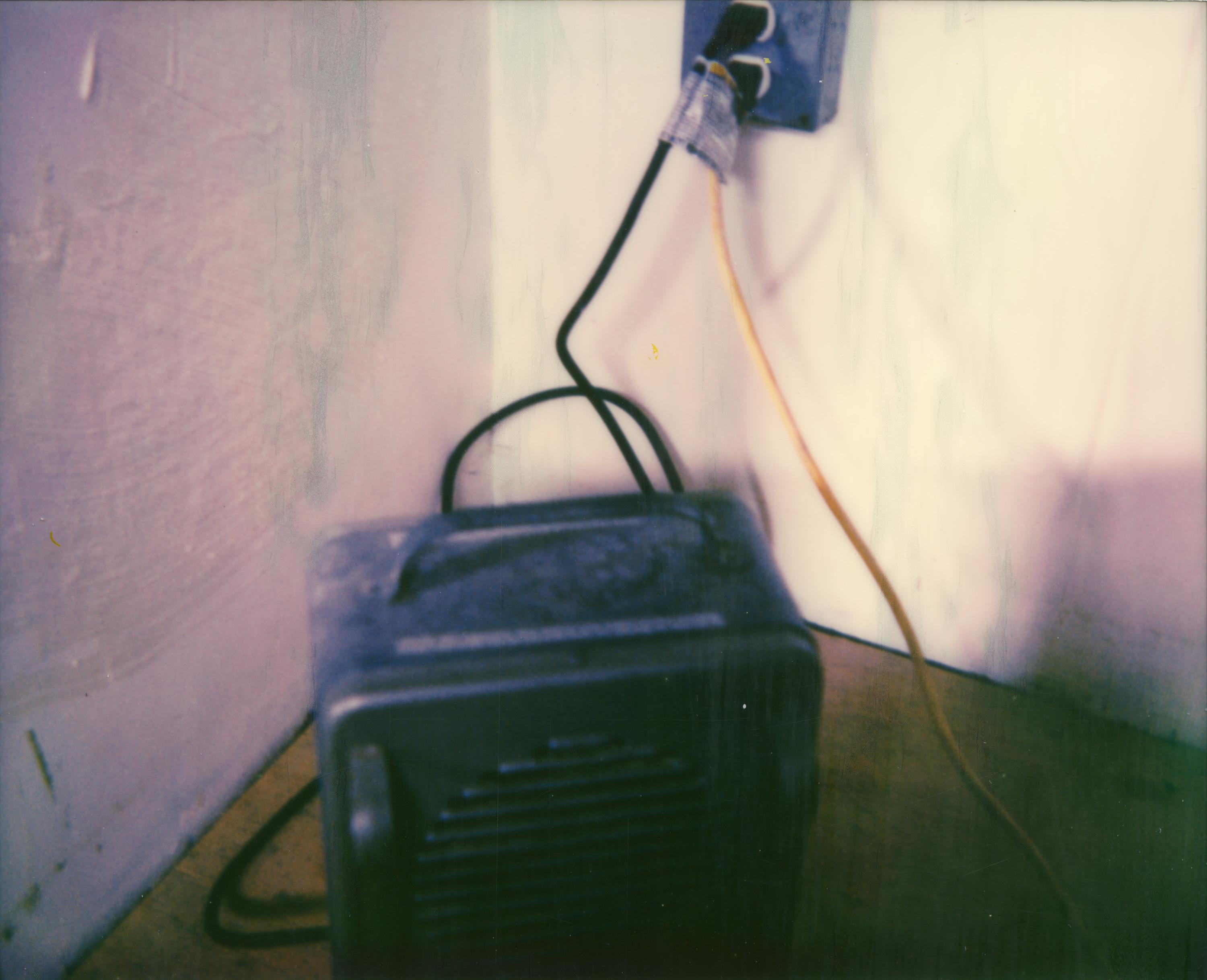Shells and Impact (Wastelands) - 2003,
Edition 2/7, each 38x37cm, installed 38x160cm,
4 Analog C-Prints, enlarged and hand-printed by the artist,
printed on Fuji Crystal Archival Paper, matte surface,
Not mounted, based on a Polaroid
Certificate and Signature Label.
Artist inventory Number 1187.01
Until he met her, his destiny was his own. Petty and inconsequential but still his own.
He was cocksure and free, young and unaccountable, with dark hair and aquiline features.
His expression was always pensive, a little troubled, but not of a maniacal sort.
He was more bored than anything else. With a heart capable of violence.
Until she met him, she was pretty but unappreciated. Her soul had registered no seismic activity.
Dust bowl weary, she’d yet to see better days. A languorous body, a sweet face with eyes that could be kind if so inclined.
Until she met him, she had not been inclined.
James Scarborough
Foreword
a speech by Mark Gisbourne
I was thinking this morning as I was drafting my comments for this evening of Slavoj Zizek, that there are a whole series of thoughts he presented in his essay called “The Art of the Ridiculous Sublime: On David Lynch’s Lost Highway,” thoughts which seem particularly apposite. Why is it that emotions and affects in the modern world seem at times ridiculous, and that in the social and political sphere ‘rhetorical sentimentalism’ seems to be the order of the day. Is it that sublimity itself (formerly the awe affected sense of life) has become driven by clichés, or, that in the post-psychoanalytic world,we no longer believe in true affects as having a viable and real content,
that meaningful feelings have become decomposed, that trust is so diminished that human relations are no longer sustainable, that transgression has become stereotyped, and that the only safe conditions of a relationship are those of an uncertain ambivalence.
I say this because the photographs of Stefanie Schneider might seem to contest these things on the one hand and reinforce them on the other. Her photo-novels, or, if you prefer photo-narratives, reveal many of these ambiguous aspects exposing the contentious
nature of what it is ‘to feel’ in our troubled world.They are multi-layered with the iconographic references that seem to span the last half century,a world driven from the existential, perhaps, Jack Kerouac’s On the Road, through the bleached and bland
simulacra of Pop Art, onto the surreal (sometimes Gothic-surreal world), presented to us by David Lynch’s films in his decentred and decomposed narratives. And, I mean a usage of the word ‘decomposed’ in its doubled sense, the decaying of emotional certainties,
alongside the decomposing aspects of telling a story in the world of today. I want to quote Zizek, not least because Stefanie Schneider uses her life-narrative to create her works, and that this life-narrative is affected by the circumstances of chance, unpredictable events, and uncertain outcomes. Zizek was speaking of the femme fatale, and by this he does not mean the cliché of the traditional Hollywood dream
factory of narrative construction (the Dietrich, Harlow, Monroe et al), though one might argue that Monroe as victim offers the mitigating point of the femme fatales transitional identity, hence her pivotal position in post-war popular culture.
“Would it not be possible to interpret the unique figure of the femme fatale in the new noir of the 90s along these lines, as exemplified in Linda Fiorentino in Dahl’s ‘The Last Seduction’ in contrast to the classic noir femme fatale on the 40s…….One can of course
argue that this new femme fatale is no less hallucinatory, that her direct approach to a man is no less the realization of a (masochist) male fantasy; however, one should not forget that this new femme fatale subverts the male fantasy precisely by way of directly and brutally realizing it, acting it out in ‘real life.’ It is thus not only that she realizes the male hallucination - she is fully aware that men hallucinate about
such a direct approach—and that directly giving them what they hallucinate about is what is the most effective way to undermine
their domination. In other words, what we have in the above-described scene from The Last Seduction (to be contrasted
to the noir femme fatale of the 40s), is the exact feminine counterpoint to the scene from David Lynch’s Wild at Heart in which Willem Defoe verbally abuses Laura Dern, forcing her to utter the words “Fuck me!”. And, when she finally does it (i.e., when her fantasy is aroused), he treats this offer of hers as an authentic free offer and politely rejects it (“No thanks, I’ve got to go, but maybe some other time….”). In both scenes the subjects are humiliated when their fantasies are brutally externalized and thrown back at them. In short Linda Fiorentino (in The Last Seduction) acts here as a true sadist, not only on account of her reduction of her partner to the bearer of partial objects which provide pleasure (thereby depriving the sexual act of its “human and emotional warmth,” and transforming it into a cold
physiological exercise), but also because of the cruel manipulation of the other’s (male) fantasy which is directly acted out and thus thwarted in its efficiency as the support of desire.” Now why have I digressed to speak of this new femme fatale? Ideas concerning
female induced seduction….. I think it is because the work of Stefanie Schneider is bound and shaped by the tensions of her emotional life, be they directly libidinal, or the sequential unfolding of the day-to-day, this is her life story. Indeed, in the press release for this exhibition, they are described as “emotional hieroglyphs in search of syntax.” They are directional but the final outcome of that direction
remains undefined, and it is this inability in the modern world to sustain ‘concrete meanings,’ and to replace it with the ‘instancy of dreams and their denial’ which is the vital currency of her work. It seems to me that her work is not about the technical aspects of images and their realization, but about the dematerialization of images contents and the emotional flux that ensues from them. This is now the
state of emotional anemia in which we now find ourselves. She lives in the world (our current world) where the boundary of ‘the real’ (in the Lacanian sense) and reality has been obfuscated. It is a journey without beginning or end, save that which encompasses all our lives.The bleached out-of-focus contents is thus a mirror of our current living condition, the Dionysian side where the state of irrational
uncertainty is the only certainty we have. There is no longer in our lives a fixed sense of fiction and fact, an end and a beginning. To tell a story as a narrative today is to say that there are no longer conditions whereby we might have a beginning, middle, and an end. Save for human biology the diachronic has been displaced by the synchronic. And this is probably the reason why most of the formulaic fodder
presented to us by Hollywood is no more than Sentimentality (a feeling that is preformulated and disposable like a Christmas card), the product of clichéd constructions driven by accountants and their bookkeeping. It is quite clear that Schneider knows this intimately, and is able to use many of these tropes in a selfreflexive manner. If her work is ironic about the subject of the so-called ‘American Dream,’ and irony is intended here in the strictly Socratean sense of its origins, that which says the opposite of what is exposed and expressed, it does so only in the sense that human emotions, feelings, and action have become increasingly opaque. As a result their transmission takes on the status of the ambiguous, something which leads ultimately to the ambivalent and unsustainable condition of human relations as they are frequently experienced today. Maybe we should think of it therefore, appropriating the title (at least), of Calderon della Barca’s “Life’s a
Dream.” Or, dream turned nightmare just as much as nightmare is turned to dream. And, this is why I want to return to the notion of passage and journeying that seems to underpin so much of her art. Indeed, the same thematic that spans the last fifty years from Kerouac to Lynch, Dahl and many other contemporary filmmakers. But it is no longer a ‘rite of passage’ in an anthropological sense, and
in which so final an outcome is achieved. It is no longer a good old-fashioned ‘Lust for Life’ an experience as end in itself, since both ‘lust’ and ‘life’ have become somehow disaggregated.And, I know that to say such a thing seems overtly pessimistic. But, that is just it, for we live increasingly with a pessimistic propensity.And, in this world of post-narratology, that is to say a world where the preordained structure of storytelling has become displaced or simply formalized, or commodified as in soap opera; for it is no longer possible to speak of a world where happiness and sadness have commensurate relations, or where drama (be it comedy or tragedy) remain in some point of fixed relations. Hence in a certain sense life has become both sublime and ridiculous, or if you like a world where as Zizek puts it fantasy
has become decomposed, or is decomposing as in the images of Stefanie Schneider, where the ‘inherent transgression’ is now the norm, where the sublime projection carries within it the worm of its own rejection, where hope is hypocritical (or at the very least rhetorical) and the outcome is purely random. Thus to have entered here onto a description of contents of Schneider’s work is to impose on you a particular reading, namely my reading, when what I want to expose or point to is a state of consciousness. Perhaps, more than that, a state of ongoing consciousness…………..A world that here brings into relations most often photography and film, the static image and the moving image.We have lived now in this decomposed experience since the 60s, perhaps, best understood by reference to Harald Szeemann’s famous exhibition ‘When Attitude Becomes Form,’ and which a curator friend of mine proposes to reconstitute in the near future, and reinterpret in the light of the last forty years, calling it not surprisingly ‘When Attitude Became Form.’
In this laudatio I have also, deliberately, perhaps, obfuscated matters insomuch as the term means “in praise of,” usually an honorary acclamation of a thing aimed for and that has been achieved…… But to have done that here this evening would have been to tell the lie of the very thing that the work of Schneider exposes, because as she has said “everything that happened in my life happened by accident and most of the time it was good. I allow chance to play a role in my life and this dictates what happens in my photography.” Tonight you are part of that chance, for though this exhibition takes place at a point fixed in time this does not negate the fact that through its contents your experience can transcend it. If you are troubled or disturbed by this, then all I can say is (perhaps, with my own feeling for humorous irony) welcome you to the world of today. It seems the world of human emotions and relations are more porous than they have ever been,
and the work Schneider negotiates the horizon of an endless uncertainty.





